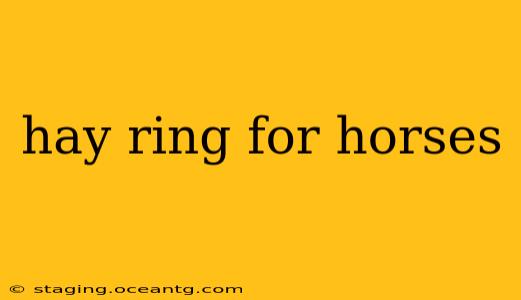Hay is a crucial part of a horse's diet, providing essential nutrients and fiber. However, simply piling hay on the ground can lead to several problems, including wasted hay, uneven consumption, and potential health issues. That's where hay rings come in. This comprehensive guide explores the benefits, types, and considerations when choosing a hay ring for your equine companion.
What are the benefits of using a hay ring for horses?
Hay rings offer a multitude of advantages that significantly improve the feeding experience for horses and simplify management for owners. Key benefits include:
- Reduced Hay Waste: Horses are less likely to trample or waste hay when it's contained within a ring. This translates to cost savings and less cleanup.
- Slows Down Eating: The design encourages slower, more deliberate eating, reducing the risk of colic and digestive upset associated with rapid consumption.
- Improved Hay Hygiene: Keeping hay off the ground prevents contamination with dirt, mud, and other debris.
- Encourages Natural Grazing Behavior: The ring mimics the natural foraging behavior of horses, promoting mental stimulation and preventing boredom.
- Easier Management: Hay rings make it easier to monitor hay consumption and adjust feeding schedules as needed.
What are the different types of hay rings for horses?
Several types of hay rings cater to different needs and preferences:
- Round Hay Rings: These are the most common type, resembling a large, circular metal frame. They are durable and readily available.
- Square/Rectangular Hay Rings: These offer slightly more space and can be beneficial for horses that prefer to feed from a larger area.
- Slow Feed Hay Nets: While not strictly hay rings, these nets are often categorized alongside them. They further slow down eating and minimize waste.
- Elevated Hay Rings: These rings are raised off the ground, promoting better posture during feeding and reducing the risk of neck strain.
What size hay ring should I choose for my horse?
The appropriate size depends on your horse's size and the amount of hay you plan to provide. A larger horse will require a larger ring to accommodate its feeding needs. Consider the following:
- Horse Size: Larger breeds may require larger rings.
- Hay Type: The type of hay can influence how much space you need within the ring. Loose hay requires more space than hay in smaller bales.
- Feeding Frequency: If you plan to refill the ring frequently, a smaller ring may suffice.
What materials are hay rings made from?
Hay rings are typically constructed from durable materials that can withstand the wear and tear of daily use:
- Metal (Steel): Metal rings are very strong and long-lasting, though they can rust if not properly maintained.
- Plastic: Plastic rings are lighter and often less expensive, but they are typically less durable than metal rings.
How do I clean a hay ring?
Regular cleaning is essential to maintain hygiene and prevent the build-up of bacteria and mold:
- Remove Leftover Hay: Empty the ring completely after each feeding.
- Wash and Rinse: Wash the ring thoroughly with soap and water, paying attention to any crevices where debris may accumulate. Allow it to dry completely before refilling.
Are there any safety concerns to consider when using hay rings?
While hay rings offer many benefits, it's crucial to consider some safety aspects:
- Ring Stability: Ensure the ring is securely anchored to prevent tipping or movement during feeding.
- Sharp Edges: Inspect the ring regularly for any sharp edges or points that could injure the horse.
- Appropriate Size: Using a ring that is too small or too large could lead to injury or inefficiency.
What are some alternatives to hay rings?
Several alternatives are available, though they might lack some of the advantages of hay rings:
- Slow Feeders: Different types of slow feeders exist to manage hay consumption.
- Hay Nets: Hay nets are commonly used to control feeding rates.
- Ground Feeding (with caution): Ground feeding can lead to significant hay waste.
By carefully considering the different aspects discussed in this guide, you can choose the optimal hay ring to enhance your horse's feeding experience and overall well-being. Remember, consulting with a veterinarian or equine nutritionist can provide tailored advice based on your horse's specific needs.
